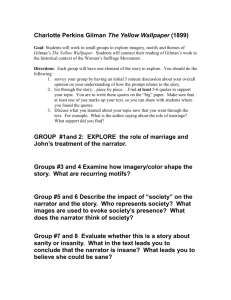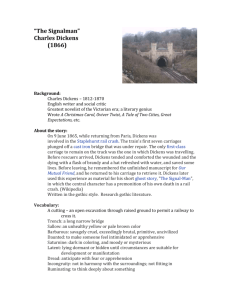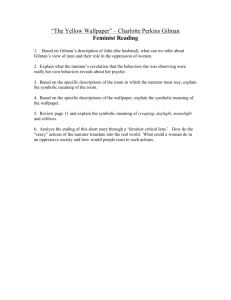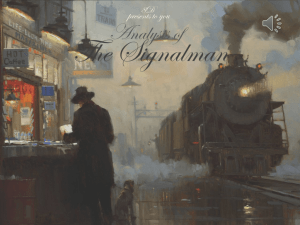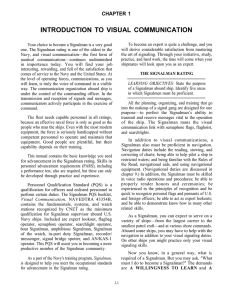Notes on IGCSE Short Stories
advertisement
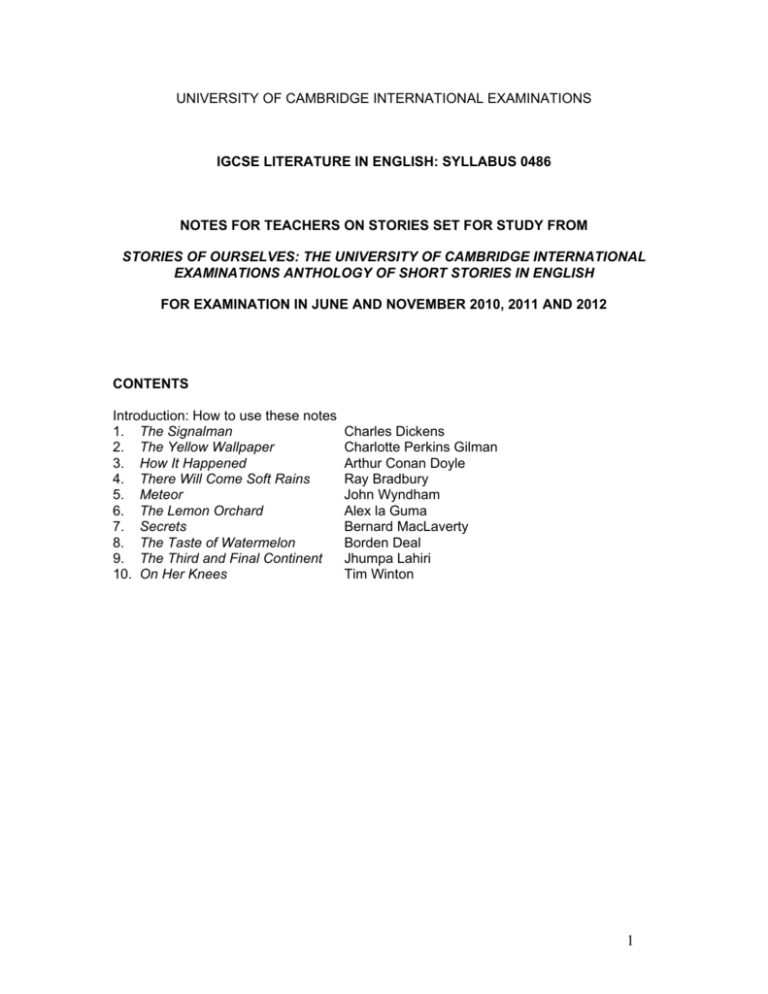
UNIVERSITY OF CAMBRIDGE INTERNATIONAL EXAMINATIONS IGCSE LITERATURE IN ENGLISH: SYLLABUS 0486 NOTES FOR TEACHERS ON STORIES SET FOR STUDY FROM STORIES OF OURSELVES: THE UNIVERSITY OF CAMBRIDGE INTERNATIONAL EXAMINATIONS ANTHOLOGY OF SHORT STORIES IN ENGLISH FOR EXAMINATION IN JUNE AND NOVEMBER 2010, 2011 AND 2012 CONTENTS Introduction: How to use these notes 1. The Signalman 2. The Yellow Wallpaper 3. How It Happened 4. There Will Come Soft Rains 5. Meteor 6. The Lemon Orchard 7. Secrets 8. The Taste of Watermelon 9. The Third and Final Continent 10. On Her Knees Charles Dickens Charlotte Perkins Gilman Arthur Conan Doyle Ray Bradbury John Wyndham Alex la Guma Bernard MacLaverty Borden Deal Jhumpa Lahiri Tim Winton 1 These notes are intended to give some background information on each author and/or story as an aid to further research and to stimulate discussion in the classroom. They are intended only as a starting point and are no substitute for the teacher’s and student’s own study and exploration of the texts. 2 Charles Dickens (1812-1870) The Signalman Charles Dickens is perhaps the foremost English 19th century novelist, famous for such works as Oliver Twist, Great Expectations and Nicholas Nickleby. A feature of many of his novels is a combination of great narrative skills with an interest in the social problems of his time. As well as his major novels, though, he also wrote a number of short stories, of which The Signalman is one. In common with a number of stories about the supernatural, the narrator of this story is a sceptic, puzzled by the signalman’s conviction that he has witnessed inexplicable events. It is the earnestness and seriousness of the signalman, though, which gradually convinces the teller of the story. The signalman himself is a storyteller, and the difficulty he has in relating his story demonstrates his psychological unease. Dickens balances the oddness of his tale and his strange actions with the affirmation that he is a sane and rational man carrying out great responsibilities on the railway; he is termed ‘the safest of men’ by the narrator, and another railway worker at the end of the story says of him ‘No man in England knew his work better.’ Dickens shapes the story and creates a final twist by linking the narrator with the signalman and the strange events in the story’s final moments. The 19th century saw a huge growth in British railways, with a number of companies building lines and running services across the country. The government began to regulate the railways in the 1840s, so Dickens centred this story on a real topical interest in 1866. There are other signs of the world of 19th century England in the story. Notice how the different class or social station between the narrator and the railway workers is apparent in the way they speak to each other throughout the story. Wider reading Try some of the longer Dickens novels, perhaps starting with one of the three listed above. Compare with The Yellow Wallpaper by Charlotte Perkins Gilman How It Happened by Arthur Conan Doyle The Hollow of the Three Hills by Nathaniel Hawthorne The Fall of the House of Usher by Edgar Allen Poe Online The Victorian Web (http://www.victorianweb.org/) is an excellent site for information about writers and the history of the period. 3 Charlotte Perkins Gilman (1860-1935) The Yellow Wallpaper This story is an important example of the Gothic tradition, where terror and horror reveal the psychological states of the characters and narrators. Here the narrator’s telling of the tale shows her own gradual loss of rationality and descent into madness. The husband John is the voice of reason and rationality, opposed to ‘horror and superstition’, but he is unable to understand his wife. Gilman’s story creates an uncertainty about his concern for his wife and her illness – does it in fact amount to oppression? The reader notes that what the narrator is forbidden to do is write, as if writing is the manifestation of her illness, which might lead to questions which occur in a number of Gothic texts about the repression of individuality and in particular the restriction of women’s roles. It is notable that the pattern on the wallpaper entraps and restricts the woman within and the narrator eventually identifies with her, saying ‘I’ve got out at last… you can’t put me back!’ Wider reading Other short stories by Charlotte Perkins Gilman include When I Was a Witch, Turned, Making a Change and If I Were a Man. Compare with The Signalman by Charles Dickens On Her Knees by Tim Winton The Hollow of the Three Hills by Nathaniel Hawthorne The Fall of the House of Usher by Edgar Allen Poe The Lady in the Looking Glass by Virginia Woolf Sandpiper by Adhaf Soueif Online Biographical and critical material on Charlotte Perkins Gilman can be found at: http://www.womenwriters.net/domesticgoddess/gilman1.html and http://www.kirjasto.sci.fi/gilman.htm 4 Arthur Conan Doyle (1859-1930) How It Happened Arthur Conan Doyle is perhaps better known for his Sherlock Holmes mysteries, but in this story it is the reader who is invited to do the detective work in an attempt to solve the very short story’s mystery before its dénouement. There are little clues, such as the narrator’s comment ‘I can live it again’ and the reference to the car as ‘roaring, golden death’, to hint at the resolution of the story before its final line. The story also concerns wilful masculine pride, in the narrator’s insistence on driving the unfamiliar vehicle, and there are frequent indications of class, with the quiet deference of the clearly more highly skilled chauffeur, Perkins, who is clearly concerned for ‘master’ despite being in considerable pain himself after the crash. It is notable that the narrator is welcomed into the world of death by someone of his own class, Stanley, ‘whom I had known at college some years before’ and whose dialogue gradually reveals the outcome of the tale. Wider reading Read some of the Sherlock Holmes stories in The Adventures of Sherlock Holmes or The Hound of the Baskervilles. Compare with The Signalman by Charles Dickens The Custody of the Pumpkin by PG Wodehouse An Englishman’s Home by Evelyn Waugh Online Biographical material and a searchable selection on online works can be found at: http://www.online-literature.com/doyle/ 5 Ray Bradbury (1920- ) There Will Come Soft Rains Bradbury has written numerous stories and novels, usually in the science fiction genre, where he shows his concerns with the trends of modern society by looking into the future. This bleak story is a good example, with the detached third person narrator describing a range of activities, which becomes more and more unnerving as the reader realises there is no human presence and all movement and voices are mechanised. The silhouettes on the wall reveal the poignant truth, showing a family destroyed while pursuing normal family activities. At the end of the story the technology destroys the home; the story suggests that man’s technology has already destroyed humanity itself. Encourage students to note Bradbury’s use of ironically human verbs applied to the machinery. Wider reading One of Ray Bradbury’s most famous novels is Fahrenheit 451, about a world where books are banned and burned, while The Pedestrian is a short story where walking has become a suspicious activity. Compare with Meteor by John Wyndham Report to the Threatened City by Doris Lessing Online Ray Bradbury’s official site is at: http://www.raybradbury.com/ 6 John Wyndham (1903-1969) Meteor While John Wyndham has been described disparagingly as ‘the master of the middleclass catastrophe’, it can be argued that he uses his settings of comfortable middle England to bring his science fiction stories uncomfortably close to his readers. This is certainly true of perhaps his most famous novel, The Day of the Triffids. The structure of Meteor, juxtaposing two separate but connected narratives, demonstrates this concern, as one of the narratives shows a group of people in a domestic setting examining a strange object, while the second narrative is a scientific journal which includes unfamiliar terms and references. As the story develops, the reader begins to see the connections between the two narratives. The amazingly advanced technology of the visitors is gradually revealed as well as their peaceable intentions, while their perspective on the human world demonstrates not only their puzzlement but gives indications as to their size. Having established this, Wyndham’s conclusion of the story is shocking. Wider reading The Midwich Cuckoos, The Day of the Triffids and The Chrysalids are three of John Wyndham’s very successful science fiction novels. The Handmaid’s Tale by Margaret Atwood Compare with There Will Come Soft Rains by Ray Bradbury Report to the Threatened City by Doris Lessing Billennium by JG Ballard Online Biographical material and a critical review of John Wyndham’s works can be found at: http://books.guardian.co.uk/authors/author/0,,-223,00.html 7 Alex la Guma (1925-1985) The Lemon Orchard Many of la Guma’s novels and short stories show his political leanings and reflect his criticism of the racially discriminative policies of the government of South Africa at the time he was writing, and the ways these policies affected human behaviour and relationships. In The Lemon Orchard, none of the characters is named. This anonymity not only adds to the atmosphere of threat in the story, but perhaps suggests that this is not a story of a particular event, but is representative of a number of such events which occurred in many places at many times in South Africa under apartheid. The companionship of the group of white men is compared with the solitary vulnerability of the ‘coloured man’ they hold captive, who displays a ‘mixture of dignity and contempt’ for his tormentors. The reader learns from snatches of dialogue that he is ‘educated’ and a ‘teacher’, but is granted no respect. The undercurrent of threat and violence instead becomes more explicit as the story continues. Its ending is open and inconclusive, unlike the final twist or revelation of so many short stories. You might encourage students to consider what the effects of this way of ending the story are. Wider reading The novel Time of the Butcherbird and the short story Coffee for the Road by Alex la Guma The Life and Times of Michael K by JM Coetzee Burger’s Daughter by Nadine Gordimer Compare with The Yellow Wallpaper by Charlotte Gilman Perkins Meteor by John Wyndham Online Biographical material and a critical review can be found at: http://www.enotes.com/twentieth-century-criticism/guma-alex-la/introduction?print=1 8 Bernard MacLaverty (1942-) Secrets Bernard MacLaverty has taught writing at various levels and is a master of the short story form, having written five collections as well as four novels. In common with a number of short stories in this anthology, Secrets presents a narrator looking back at childhood. The heart of the story is framed by the aged dying aunt; it begins with care for her and ends with the aftermath of her death. In between is a tale of a warm and affectionate relationship soured by curiosity, betrayal and guilt set against a Roman Catholic background and the effects of the First World War. The fragments of memory encapsulated in letters and photographs take the narrator and the reader further and further back into the past, and the story ends with a devastating sense of loss, which is itself a central concern of the story. Wider reading Try more of MacLaverty’s stories in Secrets and Other Stories Reading in the Dark by Seamus Deane Paddy Clark Ha Ha Ha by Roddy Doyle Dubliners by James Joyce Compare with The Taste of Watermelon by Borden Deal Games at Twilight by Anita Desai Of White Hairs and Cricket by Rohinton Mistry Online Bernard MacLaverty’s official site is at: http://www.bernardmaclaverty.com/index.htm 9 Borden Deal (1922-1985) The Taste of Watermelon The writer of a number of novels and short stories, Borden Deal frequently used his own background of farming in the southern United States of America as subject matter and inspiration. This story is an example, as the mature narrator looks back at a formative experience of his boyhood. It is a tale of adolescent bravado leading to destruction and disillusion, and while the excitement and subsequent disappointment of the theft is expertly captured, the key to the story lies in the aftermath, the discovery of misunderstandings, resolution and restitution. The boy in the story yearns for the unattainable – both the melon and Willadean – and goes through a rite of passage to discover relationships and strength of character. Wider reading Little of Borden Deal’s work remains in print, but The Least One is available. To Kill a Mockingbird by Harper Lee The Grapes of Wrath by John Steinbeck Compare with Secrets by Bernard MacLaverty Games at Twilight by Anita Desai Of White Hairs and Cricket by Rohinton Mistry Online Material on the literature of the southern states of the USA can be found at: http://www.alabamamoments.state.al.us/sec67det.html 10 Jhumpa Lahiri (1967-) The Third and Final Continent This story is taken from Jhumpa Lahiri’s first published work, the collection of stories entitled Interpreter of Maladies, which won the Pulitzer Prize in 2000. In some ways it perhaps reflects Lahiri’s own cultural and biographical background, as the Bengali narrator first encounters London and then America as he travels for education and employment. The story shows how he gradually grows accustomed to American ways though his landlady Mrs Croft, herself unfamiliar with contemporary trends and the advances of technology. There is gentle humour in the treatment of their unlikely relationship and it is a key moment in the story when Mrs Croft’s intervention breaks the reserve between husband and wife. Just as the narrator must accustom himself to his new environment in the USA, both he and his wife have to accustom themselves to each other after their traditional arranged marriage. Encourage students to consider the effects of the ending of the story, which gives the reader a sudden view of the narrator at a much later stage of his life. Wider reading Try the rest of the stories in Interpreter of Maladies and Lahiri’s first novel, The Namesake. The Joy Luck Club by Amy Tan The God of Small Things by Arundhati Roy Compare with The Yellow Wallpaper by Charlotte Perkins Gilman Games at Twilight by Anita Desai Sandpiper by Adhaf Soueif Online The publisher’s guide to Interpreter of Maladies, which includes some points for discussion, can be found at: http://www.houghtonmifflinbooks.com/readers_guides/interpreter_maladies.shtml 11 Tim Winton (1960-) On Her Knees Tim Winton has won numerous literary awards in his native Australia and internationally, his work encompassing short stories, novels and children’s fiction. This story is taken from his novel The Turning, which features a number of separate but overlapping narratives. In On Her Knees, the son’s perception of his mother’s cleaning work is contrasted with her pride and dignity, which is accentuated when she is falsely accused of theft. In balancing the son’s and mother’s argument about how to respond to the accusation, Winton demonstrates the powerlessness of a worker in such a position – ‘You can’t fight back.’ In this, the story has a wider social concern. Encourage students to consider the implications of the story’s title. Wider reading Scission and Other Stories and The Turning by Tim Winton Looking for Alibrandi by Melina Marchetta Compare with The Taste of Watermelon by Borden Deal The Third and Final Continent by Jhumpa Lahiri Of White Hairs and Cricket by Rohinton Mistry Online: Useful biographical information and a survey of Tim Winton’s work can be found at: http://www.contemporarywriters.com/authors/?p=auth03c7l393712635104 12
